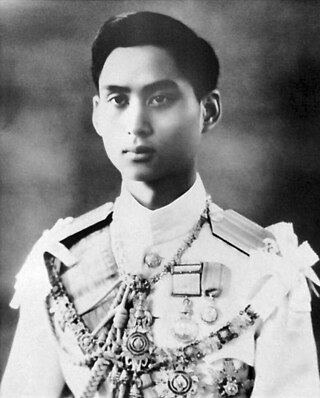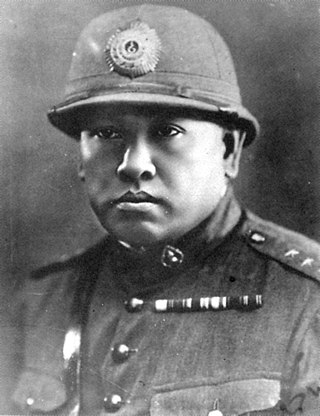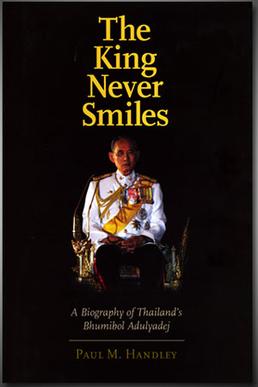
Ananda Mahidol was the eighth king of Siam from the Chakri dynasty, titled Rama VIII. At the time he was recognised as king by the National Assembly in March 1935, he was a nine-year-old boy living in Switzerland. He returned to Thailand in December 1945, but six months later, in June 1946, he was found shot dead in his bed. Although at first thought to have been an accident, his death was ruled a murder by medical examiners, and three royal aides were later executed following very irregular trials. The mysterious circumstances surrounding his death have been the subject of much controversy.

Bhumibol Adulyadej, posthumously conferred with the title Bhumibol the Great, was the ninth king of Thailand from the Chakri dynasty, titled Rama IX, from 1946 until his death in 2016. His reign of 70 years and 126 days is the longest of any Thai monarch, the longest of an independent Asian sovereign and the third longest verified reign of any monarch of a sovereign state in history after Louis XIV and Elizabeth II.

Pridi Banomyong, also known by his noble title Luang Praditmanutham, was a Thai lawyer, professor, activist, politician, and senior statesman He served in multiple ministerial posts, as regent, and as prime minister in Thailand. He led the civilian wing of Khana Ratsadon, and helped found the University of Moral and Political Sciences and the Bank of Thailand.

The Democrat Party is a Thai political party. The oldest party in Thailand, it was founded as a royalist party; it now upholds a conservative and pro-market position.

The history of Thailand from 1932 to 1973 was dominated by military dictatorships which were in power for much of the period. The main personalities of the period were the dictator Plaek Phibunsongkhram, who allied the country with Japan during the Second World War, and the civilian politician Pridi Banomyong, who founded Thammasat University and was briefly prime minister after the war.

Phraya Phahon Phonphayuhasena, simply known as Phraya Phahon, was a Thai military leader and politician. Born Phot Phahonyothin and for a brief period educated in Germany, he was a member of the Khana Ratsadon and launched a coup d'état to become Prime Minister of Siam in 1933, a position he held until 1938.

Rangsit Prayurasakdi, Prince of Chai Nat was the Thai Founder of the Public Health Ministry and as Regent of Thailand.

The King Never Smiles is an unauthorized biography of Thailand's King Bhumibol Adulyadej by Paul M. Handley, a freelance journalist who lived and worked as a foreign correspondent in Thailand. It is published by Yale University Press and was released in 2006. The book was banned in Thailand before publication, and the Thai authorities have blocked local access to websites advertising the book.
Censorship in Thailand involves the strict control of political news under successive governments, including by harassment and manipulation.

Rambai Barni, formerly Rambai Barni Svastivatana, was Queen of Siam as the wife of King Prajadhipok of Siam.

The Palace Law of Succession, Buddhist Era 2467 (1924) governs succession to the Throne of the Kingdom of Thailand, under the ruling House of Chakri. Succession matters prior to the end of absolute monarchy in 1932 could be contentious, especially during the Ayutthaya period from the 14th to 18th centuries. In 1924, King Vajiravudh attempted to clarify the succession process by laying down the Palace Law of Succession. It was promulgated and came into effect in November 1924 as, in part, an attempt to eliminate the vagueness relating to succession within the Thai monarchical regime and to systematically resolve previous controversies. In 1932, after Siam became a constitutional monarchy, various amendments relating to succession were introduced. The 1997 Constitution of Thailand relied on the law with regards to succession, but the 2006 Interim Constitution made no mention of succession, leaving it to "constitutional practice". The 2007 Constitution again relied on the Palace Law. The preamble of the 2014 interim constitution of Thailand abrogated the 2007 Constitution, with the exception of chapter 2, concerning the monarchy and the succession.

The People's Party, known in Thai as Khana Ratsadon, was a Siamese group of military and civil officers, and later a political party, which staged a bloodless revolution against King Prajadhipok's government and transformed the country's absolute monarchy to constitutional monarchy on 24 June 1932.

The Boworadet rebellion was a 1933 Thai rebellion led by royalist Prince Boworadet, as a result of the conflicts between the previous royalist regime and the succeeding constitutional regime led by Khana Ratsadon, following the Revolution of 1932. The Boworadet rebellion was eventually defeated by the Siamese Government.

The Siamese coup d’état of June 1933 took place peacefully on 20 June 1933 in Bangkok and was led was led by Army Colonel Phraya Phahonphonphayuhasena against the administration of Phraya Manopakorn Nititada. The coup was in fact a counter-coup against the dictatorial policies of Phraya Mano, stemming from his resentment of a proposal by Pridi Banomyong, the progressive leader of the Khana Ratsadon which Phahon was a member of, to reform Thailand's economy. It marked the first time in Thai history that the military successfully overthrew the constitutional government.

The Siamese revolution of 1932 or Siamese coup d'état of 1932 was a coup d'état by the People's Party which occurred in Siam on 24 June 1932. It ended Siam's centuries-long absolute monarchy rule under the Chakri dynasty and resulted in a bloodless transition of Siam into a constitutional monarchy, the introduction of democracy and the first constitution, and the creation of the National Assembly. Dissatisfaction caused by the economic crisis, the lack of a competent government, and the rise of Western-educated commoners fueled the revolution.

The coup d'état of 8 November 1947 was a military coup d'état that took place in Thailand on the evening of 8 November 1947 and ended in the early morning hours of 9 November. The coup ousted the government of Pridi Banomyong's frontman, Luang Thamrong, to make royalist Khuang Aphaiwong Prime Minister of Thailand. The coup was led by Plaek Phibunsongkhram, Phin Choonhavan and Kat Katsongkhram as a bid to regain the royalists' political power and Crown Property back from the reforms of the Siamese revolution of 1932. The influence of the People Party ended as Pridi left the country on exile.

Andrew MacGregor Marshall is a Scottish journalist and author, focusing mainly on human rights, conflict, politics and crime, mostly in Asia and the Middle East. A noted critic of the Thai monarchy and government, in June 2011, Marshall resigned from Reuters in controversial circumstances after the news agency refused to publish exclusive stories he was writing on the Thai monarchy. His 2014 book A Kingdom in Crisis was banned in Thailand and a prominent Thai royalist made a formal complaint to police accusing Marshall of several crimes including lèse majesté.

Somsak Jeamteerasakul is a former history lecturer at the Faculty of Liberal Arts, Thammasat University. His academic field is contemporary political history, especially recent Thai history from 1930. He is a critic of Thailand's monarchy and its lèse majesté law. He has lived in self-imposed exile in France since the 2014 Thai coup d'état, following violent attacks and lèse majesté charges.
The year 1946 was the 165th year of the Rattanakosin Kingdom of Thailand. It was the twelfth and last year in the reign of King Ananda Mahidol, the first year in the reign of Bhumibol Adulyadej, and is reckoned as year 2489 in the Buddhist Era.
Prince Anusorn Mongkolkarn was a Thai film director and 1996 National Artist of Thailand recipient. He was a grandson of King Chulalongkorn, and also one of the indirect first-degree cousins to Kings Ananda Mahidol and Bhumibol Adulyadej as well as Princesses Galyani Vadhana and Bejaratana, since his father, Prince Yugala Dighambara was one of the paternal half-brothers of King Vajiravudh, King Prajadhipok and Prince Mahidol Adulyadej.
















